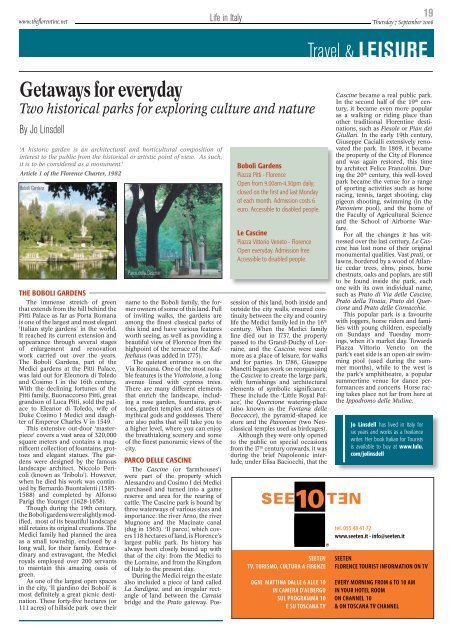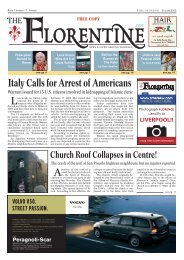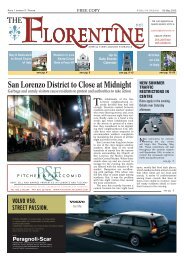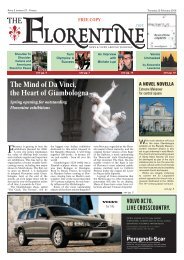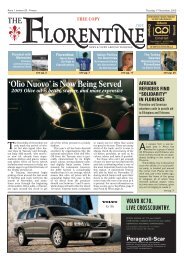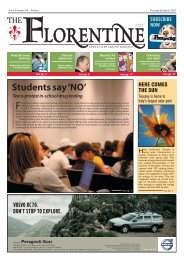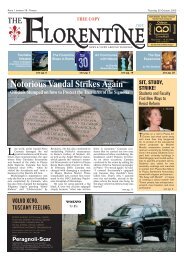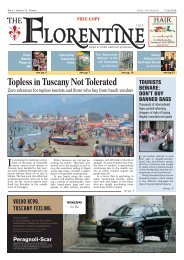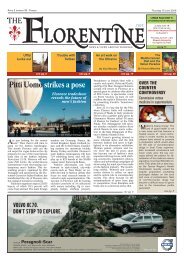Italy's favourite son, finally moving out - The Florentine
Italy's favourite son, finally moving out - The Florentine
Italy's favourite son, finally moving out - The Florentine
You also want an ePaper? Increase the reach of your titles
YUMPU automatically turns print PDFs into web optimized ePapers that Google loves.
www.theflorentine.net<br />
Life in Italy<br />
19<br />
Thursday 7 September 2006<br />
Travel & LEISURE<br />
Getaways for everyday<br />
Two historical parks for exploring culture and nature<br />
By Jo Linsdell<br />
‘A historic garden is an architectural and horticultural composition of<br />
interest to the public from the historical or artistic point of view. As such,<br />
it is to be considered as a monument.’<br />
Article 1 of the Florence Charter, 1982<br />
Boboli Gardens<br />
THE BOBOLI GARDENS<br />
<strong>The</strong> immense stretch of green<br />
that extends from the hill behind the<br />
Pitti Palace as far as Porta Romana<br />
is one of the largest and most elegant<br />
‘Italian style gardens’ in the world.<br />
It reached its current extension and<br />
appearance through several stages<br />
of enlargement and renovation<br />
work carried <strong>out</strong> over the years.<br />
<strong>The</strong> Boboli Gardens, part of the<br />
Medici gardens at the Pitti Palace,<br />
was laid <strong>out</strong> for Eleonora di Toledo<br />
and Cosimo I in the 16th century.<br />
With the declining fortunes of the<br />
Pitti family, Buonaccorso Pitti, great<br />
grand<strong>son</strong> of Luca Pitti, sold the palace<br />
to Eleanor di Toledo, wife of<br />
Duke Cosimo I Medici and daughter<br />
of Emperor Charles V in 1549.<br />
This extensive <strong>out</strong>-door ‘masterpiece’<br />
covers a vast area of 320,000<br />
square meters and contains a magnificent<br />
collection of fountains, grottoes<br />
and elegant statues. <strong>The</strong> gardens<br />
were designed by the famous<br />
landscape architect, Niccolo Pericoli<br />
(known as ‘Tribolo’). However,<br />
when he died his work was continued<br />
by Bernardo Buontalenti (1585-<br />
1588) and completed by Alfonso<br />
Parigi the Younger (1628-1658).<br />
Though during the 19th century,<br />
the Boboli gardens were slightly modified,<br />
most of its beautiful landscape<br />
still retains its original creations. <strong>The</strong><br />
Medici family had planned the area<br />
as a small township, enclosed by a<br />
long wall, for their family. Extraordinary<br />
and extravagant, the Medici<br />
royals employed over 200 servants<br />
to maintain this amazing oasis of<br />
green.<br />
As one of the largest open spaces<br />
in the city, ‘Il giardino dei Boboli’ is<br />
most definitely a great picnic destination.<br />
<strong>The</strong>se forty-five hectares (or<br />
111 acres) of hillside park owe their<br />
Parco della Cascine<br />
name to the Boboli family, the former<br />
owners of some of this land. Full<br />
of inviting walks, the gardens are<br />
among the finest classical parks of<br />
this kind and have various features<br />
worth seeing, as well as providing a<br />
beautiful view of Florence from the<br />
highpoint of the terrace of the Kaffeehaus<br />
(was added in 1775).<br />
<strong>The</strong> quietest entrance is on the<br />
Via Romana. One of the most notable<br />
features is the Viottolone, a long<br />
avenue lined with cypress trees.<br />
<strong>The</strong>re are many different elements<br />
that enrich the landscape, including<br />
a rose garden, fountains, grottoes,<br />
garden temples and statues of<br />
mythical gods and goddesses. <strong>The</strong>re<br />
are also paths that will take you to<br />
a higher level, where you can enjoy<br />
the breathtaking scenery and some<br />
of the finest panoramic views of the<br />
city.<br />
Boboli Gardens<br />
Piazza Pitti - Florence<br />
Open from 9.00am-4.30pm daily;<br />
closed on the fi rst and last Monday<br />
of each month. Admission costs 6<br />
euro. Accessible to disabled people.<br />
Le Cascine<br />
Piazza Vittorio Veneto - Florence<br />
Open everyday. Admission free.<br />
Accessible to disabled people.<br />
PARCO DELLE CASCINE<br />
<strong>The</strong> Cascine (or ‘farmhouses’)<br />
were part of the property which<br />
Alessandro and Cosimo I dei Medici<br />
purchased and turned into a game<br />
reserve and area for the rearing of<br />
cattle. <strong>The</strong> Cascine park is bound by<br />
three waterways of various sizes and<br />
importance: the river Arno, the river<br />
Mugnone and the Macinate canal<br />
(dug in 1563). ‘Il parco’, which covers<br />
118 hectares of land, is Florence’s<br />
largest public park. Its history has<br />
always been closely bound up with<br />
that of the city: from the Medici to<br />
the Lorraine, and from the Kingdom<br />
of Italy to the present day.<br />
During the Medici reign the estate<br />
also included a piece of land called<br />
La Sardigna, and an irregular rectangle<br />
of land between the Carraia<br />
bridge and the Prato gateway. Possession<br />
of this land, both inside and<br />
<strong>out</strong>side the city walls, ensured continuity<br />
between the city and country<br />
life the Medici family led in the 16 th<br />
century. When the Medici family<br />
line died <strong>out</strong> in 1737, the property<br />
passed to the Grand-Duchy of Lorraine,<br />
and the Cascine were used<br />
more as a place of leisure, for walks<br />
and for parties. In 1786, Giuseppe<br />
Manetti began work on reorganising<br />
the Cascine to create the large park,<br />
with furnishings and architectural<br />
elements of symbolic significance.<br />
<strong>The</strong>se include the ‘Little Royal Palace’,<br />
the Quercione watering-place<br />
(also known as the Fontana delle<br />
Boccacce), the pyramid-shaped ice<br />
store and the Pavoniere (two Neoclassical<br />
temples used as birdcages).<br />
Although they were only opened<br />
to the public on special occasions<br />
from the 17 th century onwards, it was<br />
during the brief Napoleonic interlude,<br />
under Elisa Baciocchi, that the<br />
<br />
<br />
<br />
<br />
<br />
<br />
Cascine became a real public park.<br />
In the second half of the 19 th century,<br />
it became even more popular<br />
as a walking or riding place than<br />
other traditional <strong>Florentine</strong> destinations,<br />
such as Fiesole or Pian dei<br />
Giullari. In the early 19th century,<br />
Giuseppe Cacialli extensively renovated<br />
the park. In 1869, it became<br />
the property of the City of Florence<br />
and was again restored, this time<br />
by architect Felice Francolini. During<br />
the 20 th century, this well-loved<br />
park became the venue for a range<br />
of sporting activities such as horse<br />
racing, tennis, target shooting, clay<br />
pigeon shooting, swimming (in the<br />
Pavoniere pool), and the home of<br />
the Faculty of Agricultural Science<br />
and the School of Airborne Warfare.<br />
For all the changes it has witnessed<br />
over the last century, Le Cascine<br />
has lost none of their original<br />
monumental qualities. Vast prati, or<br />
lawns, bordered by a wood of Atlantic<br />
cedar trees, elms, pines, horse<br />
chestnuts, oaks and poplars, are still<br />
to be found inside the park, each<br />
one with its own individual name,<br />
such as Prato di Via delle Cascine,<br />
Prato della Tinaia, Prato del Quercione<br />
and Prato delle Cornacchie.<br />
This popular park is a <strong>favourite</strong><br />
with joggers, horse riders and families<br />
with young children, especially<br />
on Sundays and Tuesday mornings,<br />
when it’s market day. Towards<br />
Piazza Vittorio Veneto on the<br />
park’s east side is an open-air swimming<br />
pool (used during the summer<br />
months), while to the west is<br />
the park’s amphitheatre, a popular<br />
summertime venue for dance performances<br />
and concerts. Horse racing<br />
takes place not far from here at<br />
the Ippodromo delle Muline.<br />
Jo Linsdell has lived in Italy for<br />
six years and works as a freelance<br />
writer. Her book Italian for Tourists<br />
is available to buy at www.lulu.<br />
com/jolinsdell


